Foreword / YouTube Video Review
This item was purchased myself through Amazon. I was not paid nor given anything in return for this review. If, after reading this review, you find your are interested in purchasing this item then please consider using the below affiliate link. This link earns me a small commission at no additional cost to you.
All my reviews are done on my own time with great care to give you all the best set of data and information I can provide in order to help you make a well-informed purchase decision. I offer this for free to all who are interested. In return, if you want to support this site please see the bottom of this review for ways you can help. It is greatly appreciated.
The review on this website is a brief overview and summary of the objective performance of this processor. It is not intended to be a deep dive. Moreso, this is information for those who prefer “just the facts” and prefer to have the data without the filler. The video below has more discussion with respect to the technical merits and subjective notes.
Information and Photos
Some specs from the manufacturer are below and full specs can be found here.
- Dual-Mode Innovation: This new generation mini amplifier offers both stereo and mono modes, adapts flexibly to your diverse needs, allowing seamless mode switching. In stereo mode, it delivers a robust output of up to 180W, while in mono mode, the power soars to a maximum of 235W. Pair two ZA3 units in mono configuration to create a powerful audio system, significantly enhancing your listening experience.
- Richer Connectivity: Debut amplifier with balanced input and trigger in, the ZA3 features a balanced combo audio signal input connector supporting both XLR and 1/4” TRS plugs. This design minimizes interference and reduces noise floor. The 12V trigger-in connector enables synchronization with other devices, streamlining the process of turning on/off without individual operations.
- Audiophile-Grade Components: The ZA3 features the TPA3255 high-end Class-D amp chip and utilizes premium Japanese NCC, ELNA, and German WIMA capacitors, and Japanese Sumida inductors for exceptional audio quality. With a SINAD rating of up to 89dB, an SNR of up to 106dB, and a low noise floor of only 150μV, it delivers exceptional clarity and low distortion.
- Advanced Heat Dissipation: Based on V3’s groundbreaking heat dissipation design, we upgraded ZA3’s cooling system by featuring a larger chassis, moving vents to the sides, and adding dust covers to achieve better ventilation for a sustained and stable high power output.
- Enhanced Scalable Fun: Personalize your audio experience with the op-amp rolling feature! The ZA3 stocks five swappable op-amps for left and right channel outputs, balanced input, and subwoofer output. Experiment with compatible DIP8 dual op-amps such as Sparkos SS3602, MUSES02, OPA2604, OPA2134PA, OP249, AD827, RM4558, LM4562, LME49720HA, etc. to fine-tune your sound to perfection.

As of this writeup, the MSRP is approximately $150 USD.
Test Setup Information:
Testing was conducted using the Quant Asylum QA402.
- Warmup: Unit was provided pink noise with an output of 1 watt into a 4-ohm load for 10 minutes.
- Test Bandwidth: 22.4kHz (48 kHz Sample Rate) (unless otherwise stated).
- FFT Size: 64k (unless otherwise stated).
- Input to DUT: Phono (RCA).
- Output from DUT: Phono (RCA).
- Volume/Gain: Max.
- DSP Settings: None Unless Otherwise Specified.
- Tests were run at 4 and 8-ohm loads. Both channels loaded. However, due to server space costs, results published here are based upon the 4-ohm testing (unless otherwise noted).
- Beyond the static loads mentioned above, Reactive Loads were also used for testing and noted. Both a “simple” and “complex” load. These are designed to emulate a true speaker load without risking damaging a real speaker or deafening myself to test tones from a real speaker. The impedance sweep of these loads are provided below.
Reactive Loads Impedance
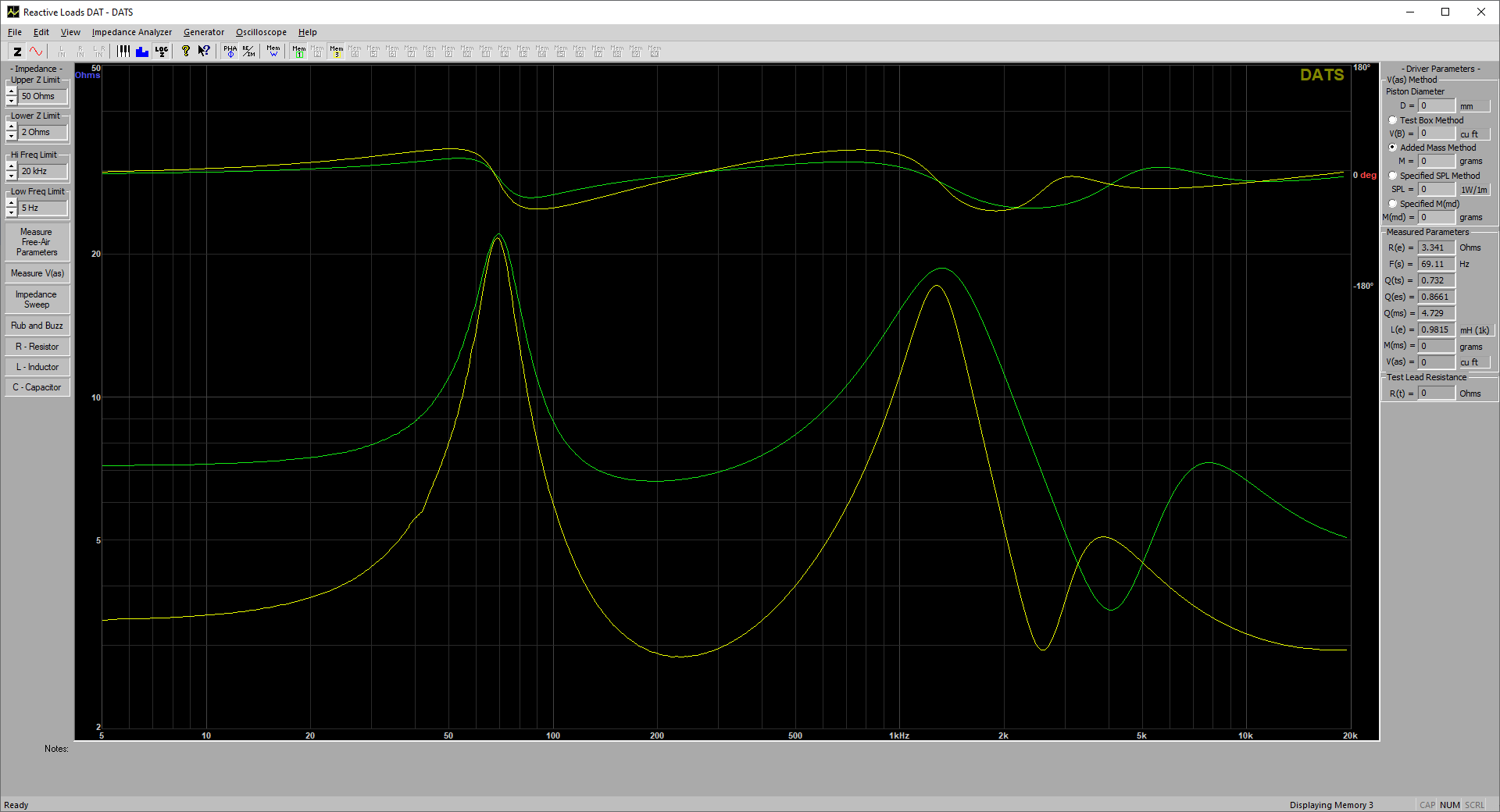
Frequency Response
Response shows some load dependency of the speaker outputs.
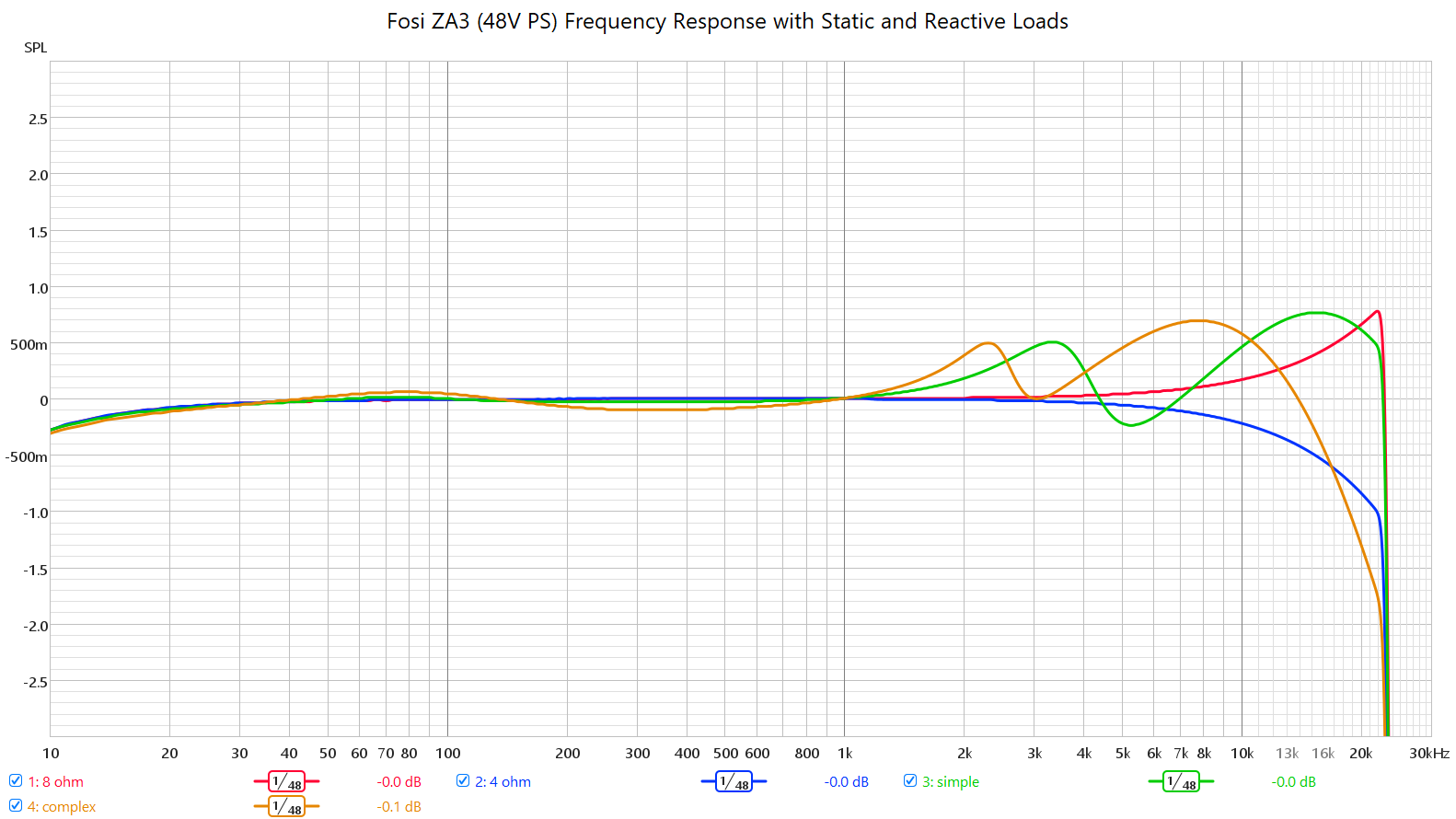
Subwoofer Channel Output
Note that speaker output is full-range when subwoofer is connected.
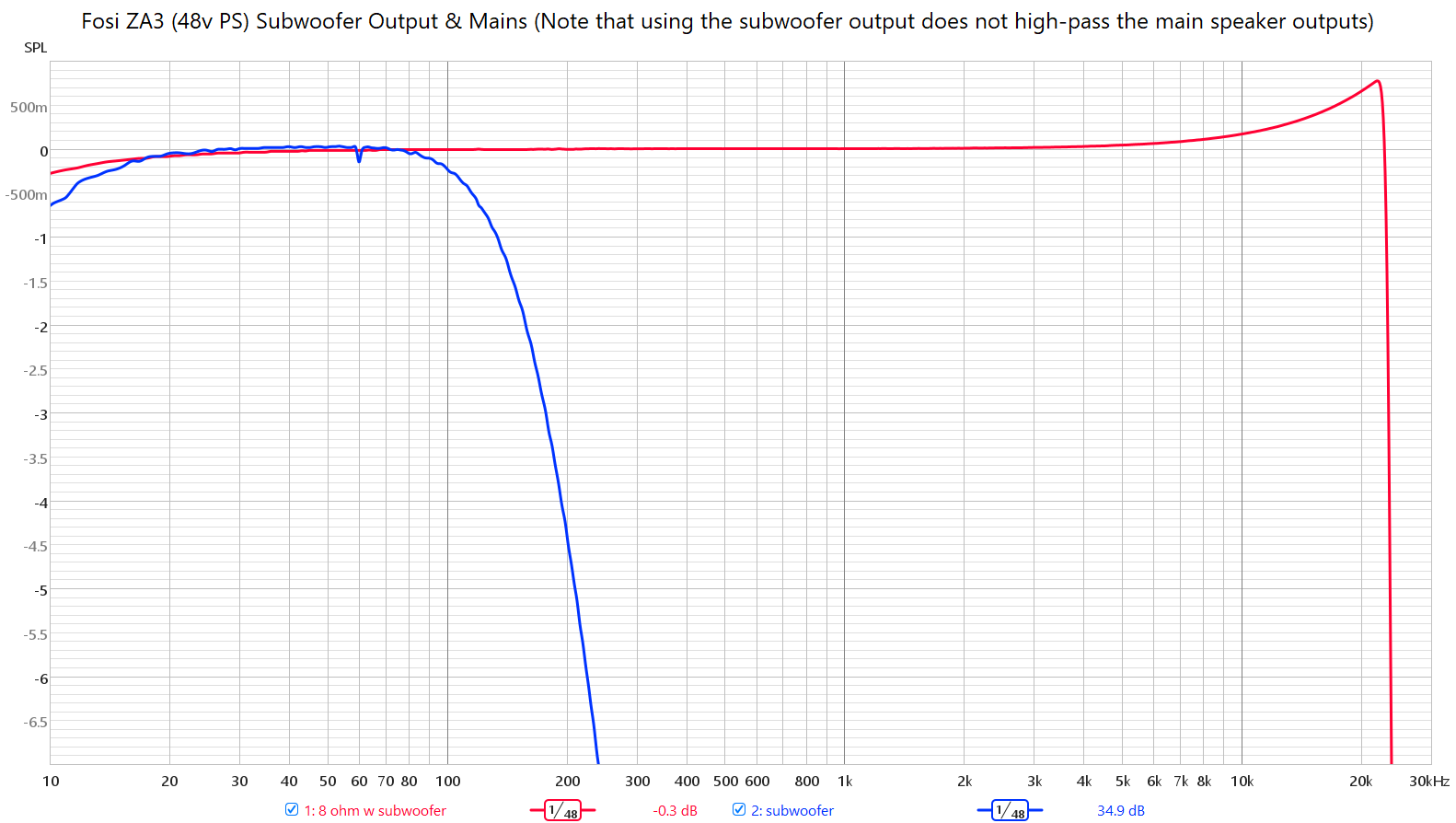
THD vs Power (1kHz)
The below graphic shows the THD as output level increases from left to right on the X-axis. I am showing only one channel here - which is the worst channel - for each load. This test is conducted wtih a 1kHz tone (as is standard).
Note that 4 ohm results are quite a bit short of the manufacturer specification when both channels are driven as you see below.
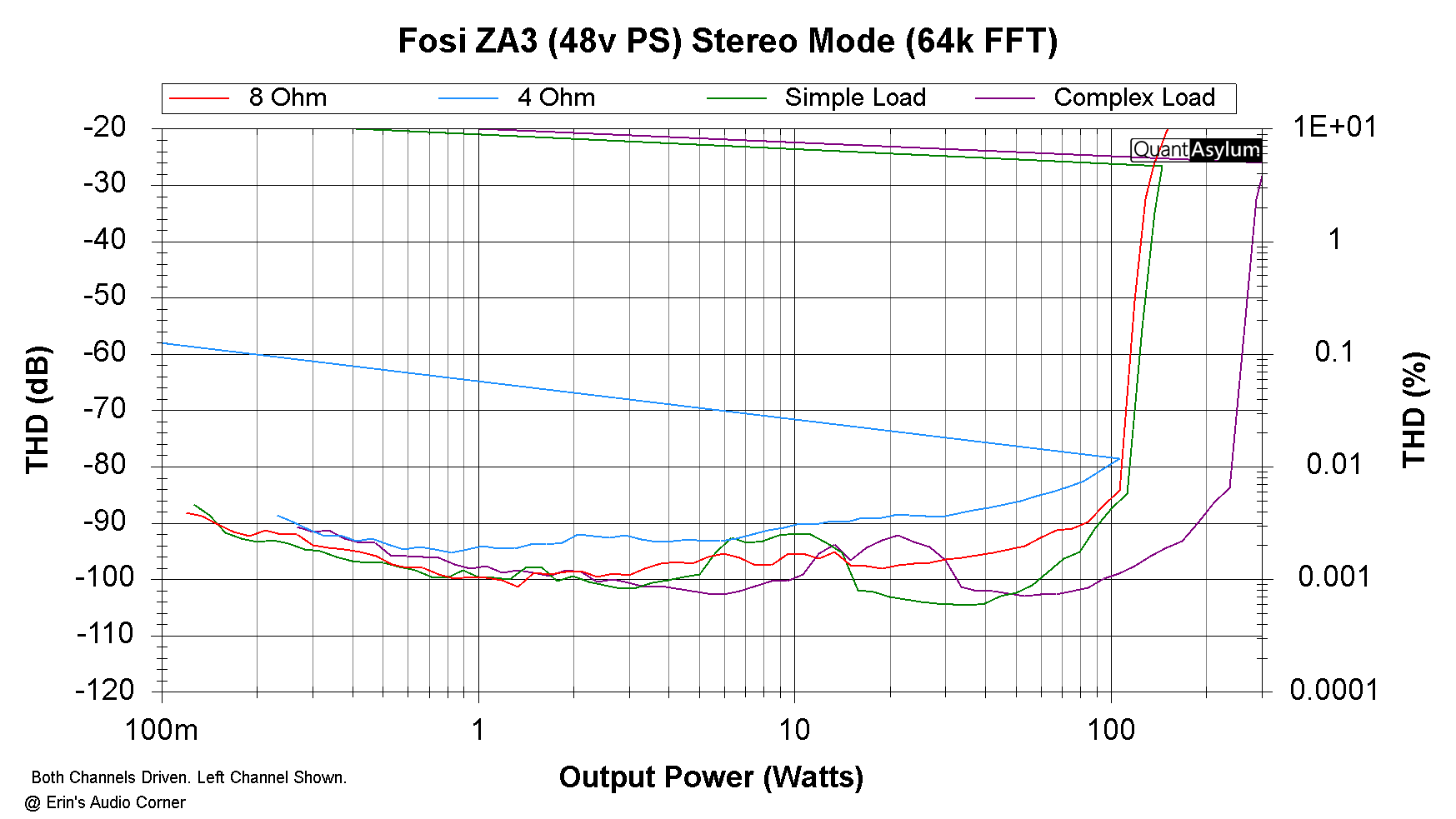
After investigation I found that stimulus length has a pretty big influence on the test above. Below is the same test as above but using an FFT length of 8k which is a faster pulse and results in a higher power output rating at 4 ohm than the above.
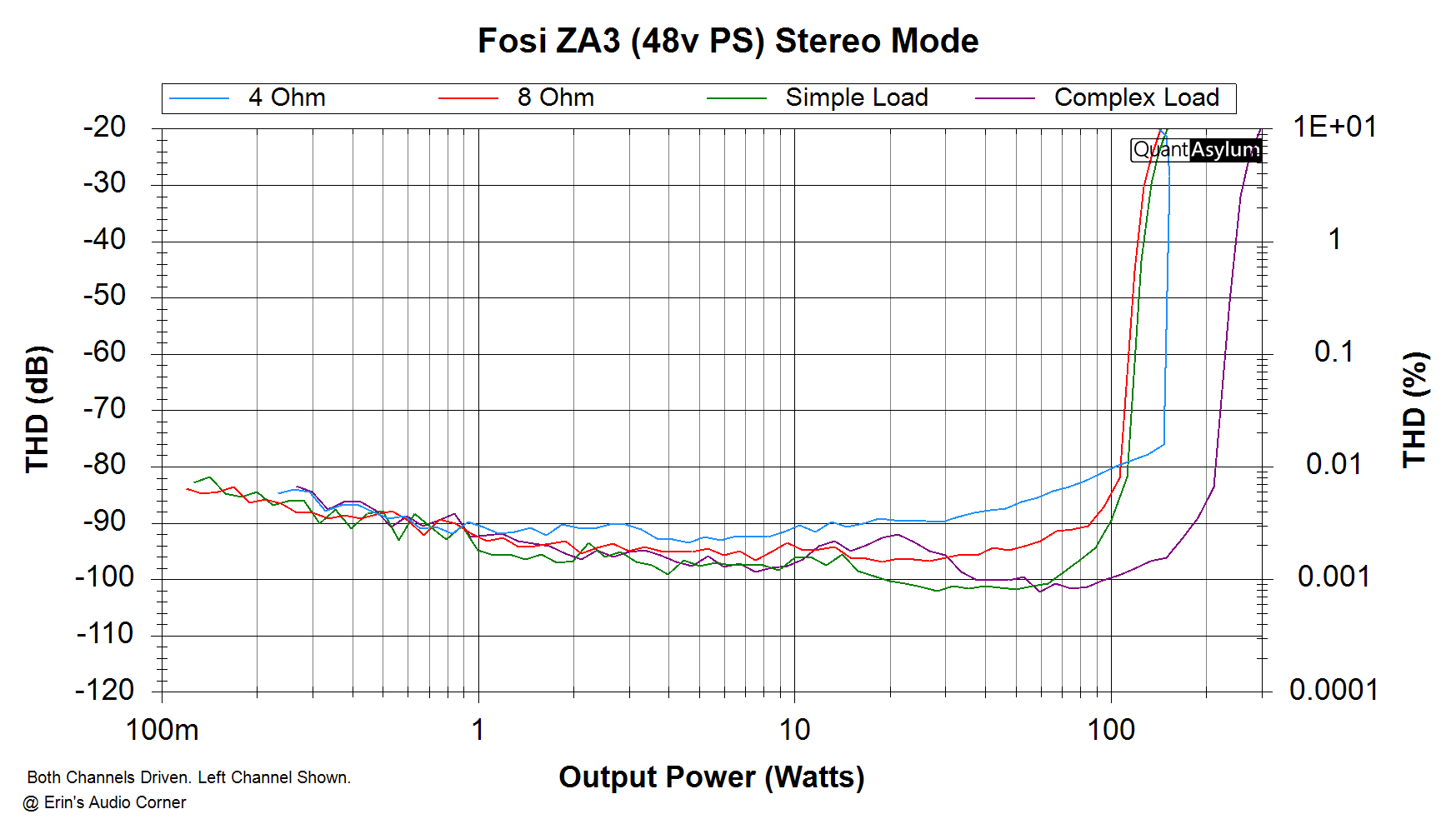
THD vs Frequency
The below graphic shows the THD as frequency increases from left to right on the X-axis. I am showing only one channel here - which is the worst channel - for each load. The highest drive level in this test corresponds to the manufacturer’s rated power.
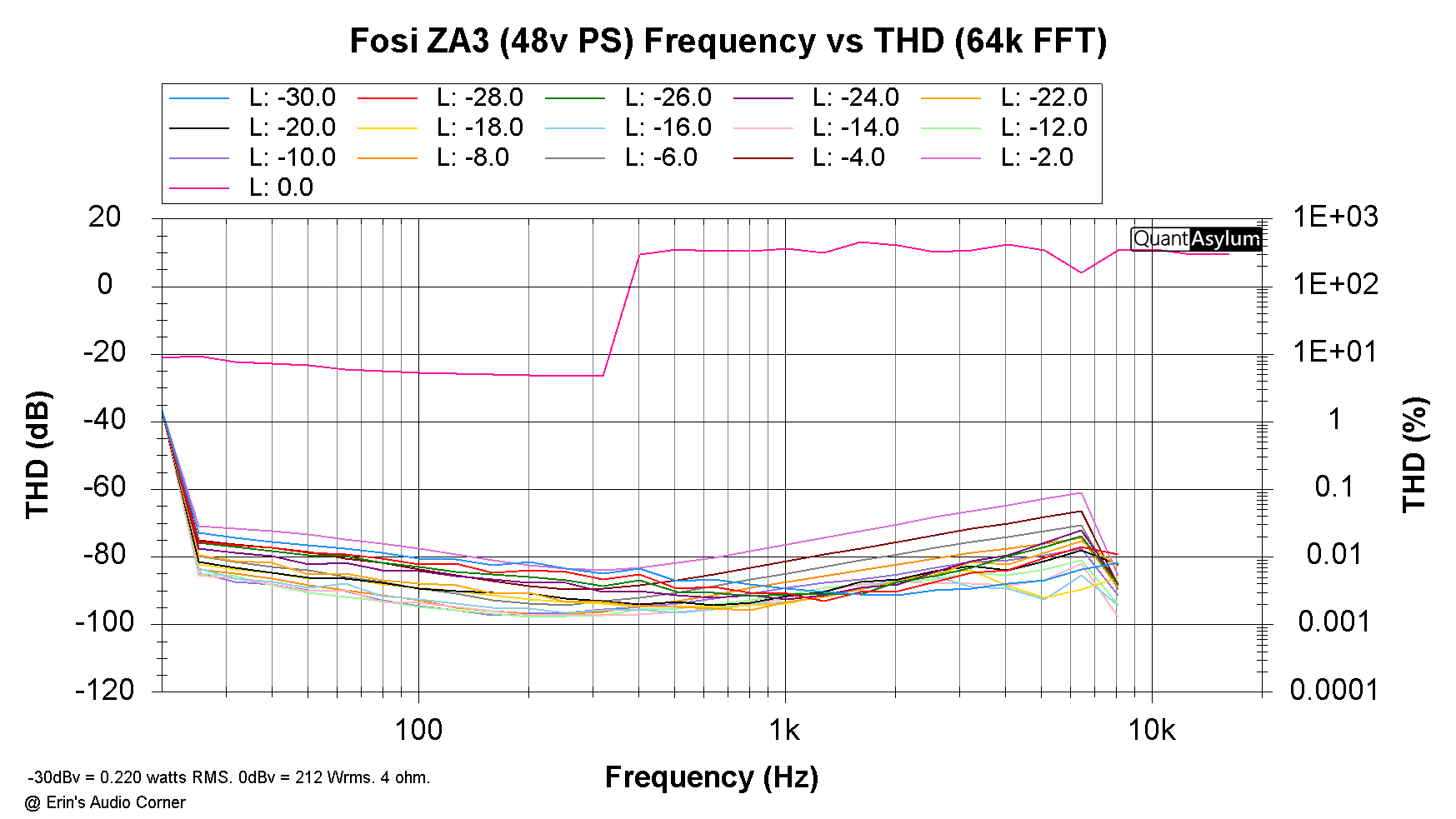
Power Degradation
The below section pertains to power capability at low volume vs high volume when two test signals are used: a) 1kHz tone and b) Multitone signal.
I typically provide 4 ohm results but in this case, as you can see in the THD vs Power results above, when this amp is driving (2) 4 ohm loads for longer than a flash of an instant the amplifier goes into protect. Therefore, I cannot provide the “at rated power” result for this 1kHz vs Multitone test at 4 ohm.
Please watch the linked video for more information.
Output Impedance:

Parting / Random Thoughts
See video linked above for subjective and objective analysis. A summarized transcript is provided below:
While my testing resulted in a pretty significant “fail” for 4-ohm stereo testing, the use of this amplifier for different speakers didn’t result in the amplifier going into protect. Still, I am quite disappointed in the objective results of this 4 ohm test.
My other complaint is that the main speaker outputs are not high-passed when the subwoofer output is engaged. You therefore have both your mains and your subwoofer playing below ~120Hz (-3dB point of the subwoofer LPF).
For $150 I’m kind of “meh” on the objective performance. It’s a case of “might be fine”, and it was for my in-room use but the results of my testing and the subwoofer/mains not being properly filtered as a combo are disappointing.
Support / Contribute
If you find this review helpful and want to help support the cause that would be AWESOME! There are a few ways you can do so below. Your support helps me pay for new items to test, hardware, miscellaneous items needed for testing, new speakers to review and costs of the site’s server space and bandwidth. Any help is very much appreciated.
Join my Patreon: Become a Patron!
Shopping
If you want to help but can’t chip in directly and you are shopping at any of the following stores then please consider using my generic affiliate links below to make the purchase through.
Purchases through these links can earn me a small commission - at no additional cost to you - and help me continue to provide the community with free content and reviews. Doesn’t matter if it’s a TV from Crutchfield, budget speakers from Audio Advice or a pair of socks from Amazon, just use the link above before you make your purchase. Thank you!
